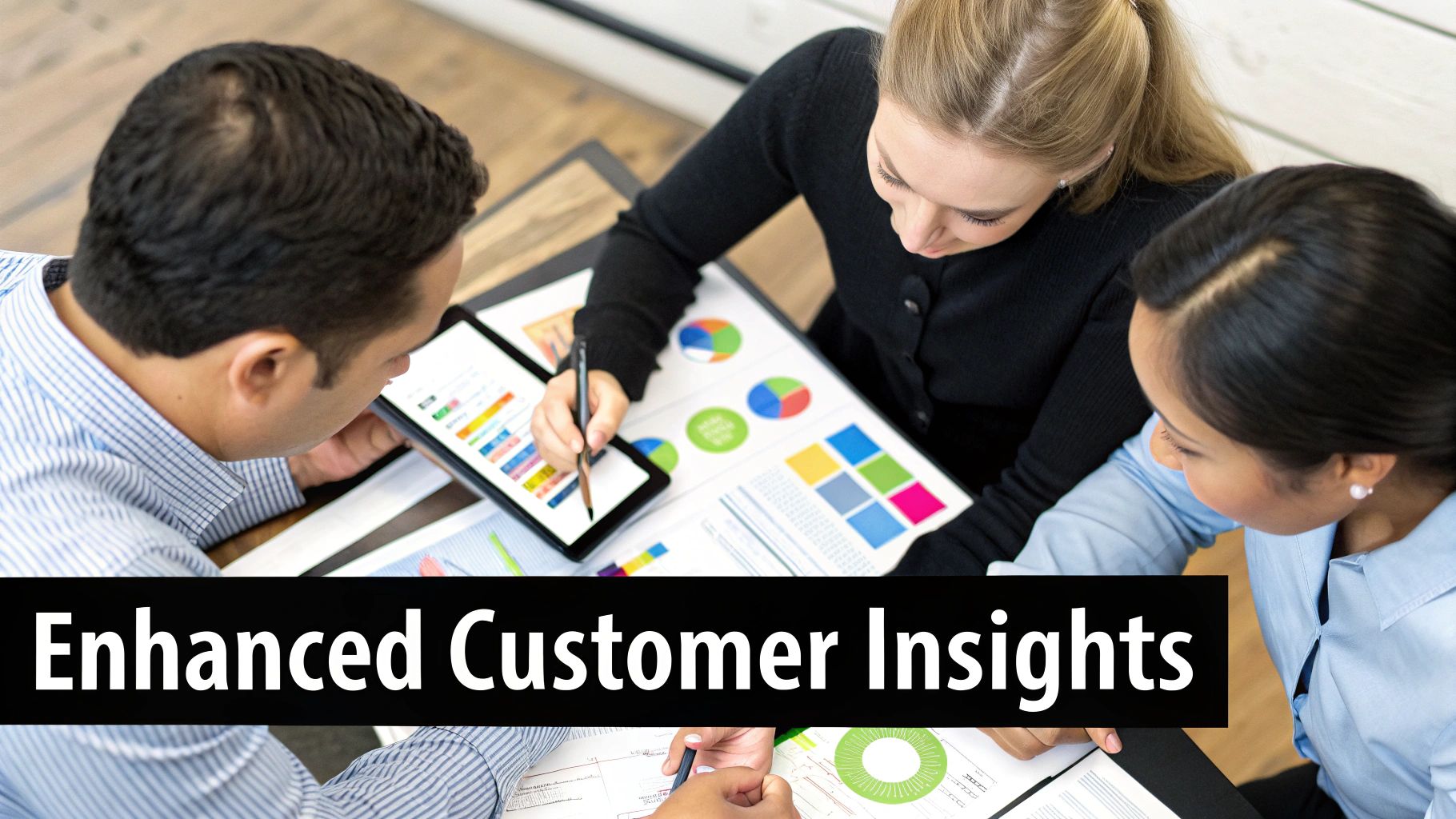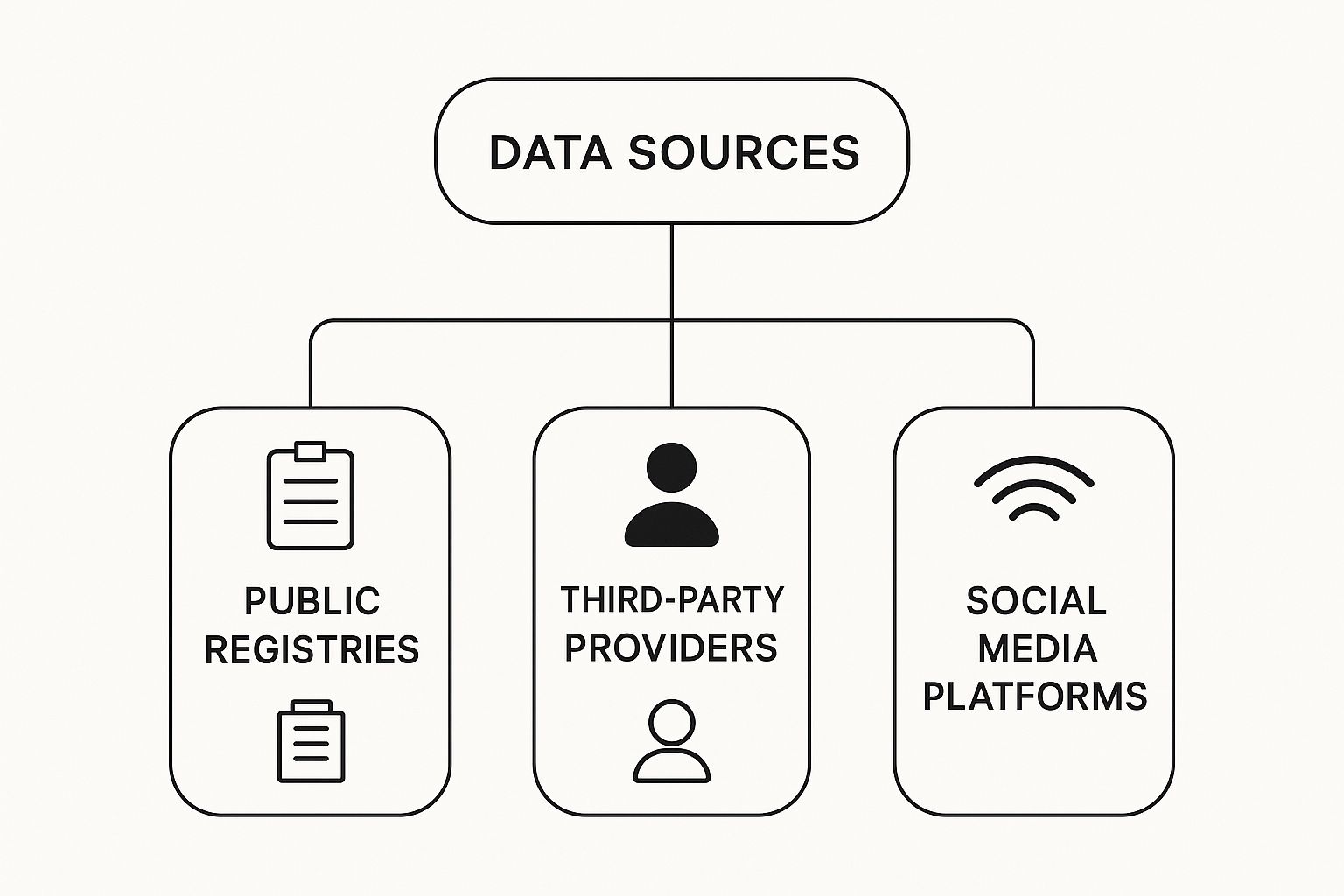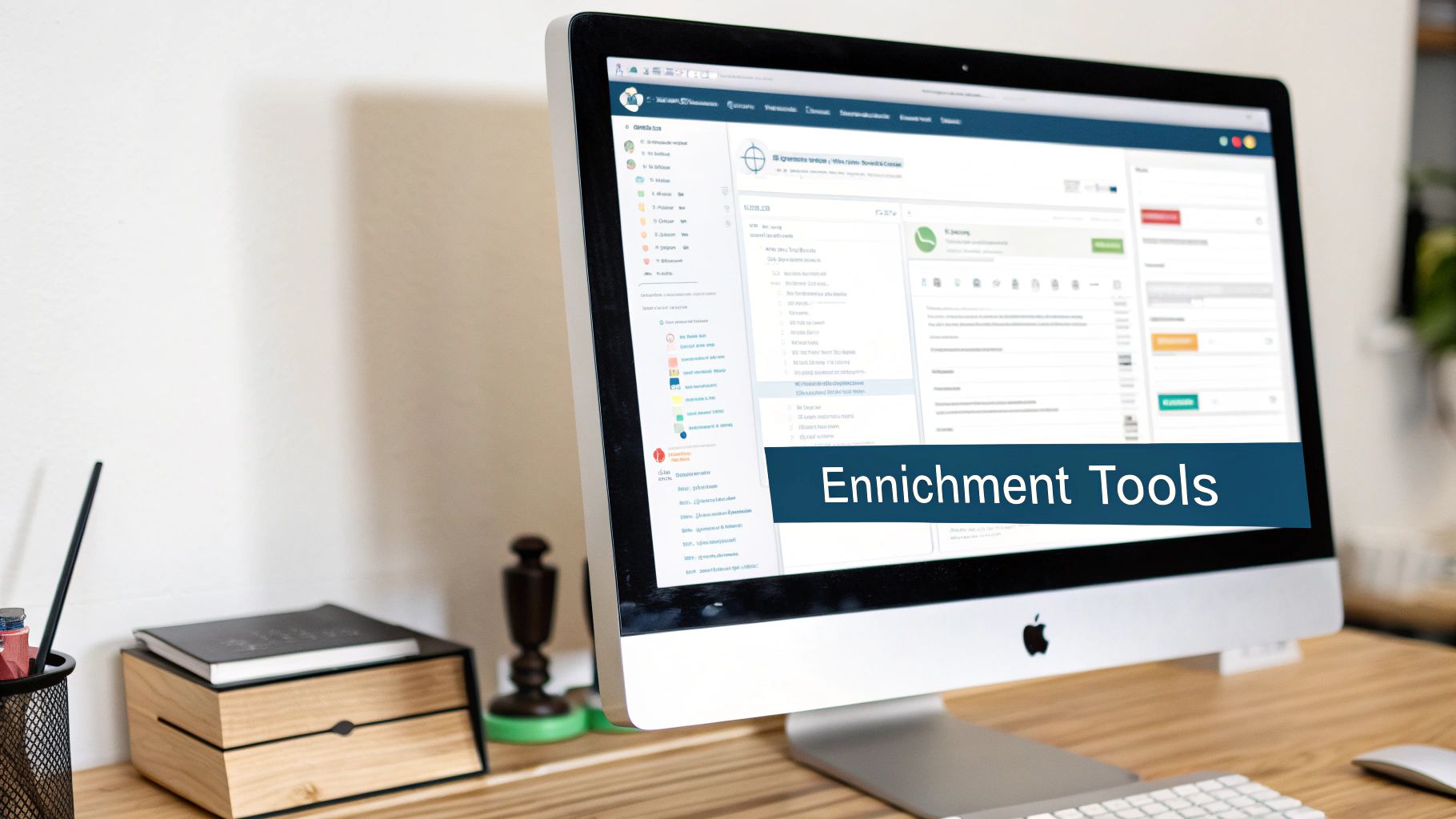CRM data enrichment is all about taking the basic information you have on customers in your CRM and making it smarter by adding details from other places. It’s the process of turning a simple contact list into a collection of complete, actionable customer profiles. The result? Your data becomes far more accurate and valuable for everyone in sales and marketing, giving you a much clearer picture of who you're talking to.
What Is CRM Data Enrichment, Really?

Think of your CRM as a basic street map. When you first get it, it probably shows street names and a few major intersections—the equivalent of a contact's name, email, and maybe a phone number. It’s useful, but it’s missing the context you need to make smart moves. You don't know which streets are one-way, where the rush hour traffic is, or which roads lead to the best neighborhoods. This is the reality for too many sales teams trying to work with skeletal data.
CRM data enrichment is what turns that flat map into a live, dynamic GPS. It takes that foundational contact info and layers on valuable intelligence from third-party sources. All of a sudden, your map comes alive with real-time information.
From a Static List to a Dynamic Sales Engine
Instead of just a name and an email, an enriched profile can tell you the contact's current job title, the size of their company, what industry they're in, and even what technologies they're using. This isn't just about piling on more data for the sake of it. It’s about adding the right data.
This process transforms your CRM from a passive, glorified address book into a proactive sales intelligence tool. It helps you see the complete picture of your prospects and customers, which is the foundation for any effective strategy.
The real goal of CRM data enrichment is to turn basic records into deep customer profiles. This is what fuels personalized engagement, sharpens your segmentation, and ultimately leads to better business decisions by turning raw data into strategic insight.
The Anatomy of an Enriched Profile
So, what kind of information are we actually talking about here? The data added during enrichment usually falls into a few key categories, and each one gives your sales and marketing teams a different kind of advantage.
Here are a few examples of what CRM data enrichment adds to a simple contact record:
- Firmographic Data: This is all about the company itself—things like industry, annual revenue, number of employees, and where they're located. It’s essential for qualifying leads and making sure you're talking to businesses that fit your ideal customer profile (ICP).
- Demographic Data: This gets more personal, focusing on individual details like a person's job title, seniority level, and role in the company. Knowing you’re talking to a C-level executive versus an intern is a game-changer.
- Technographic Data: This gives you a peek into a company's tech stack, from their marketing automation software to their cloud provider. For any tech company, this is gold. It helps you find customers who are a perfect fit or spot opportunities to win business from a competitor.
- Intent Data: This is the really clever stuff. It tracks a company's online behavior to spot buying signals, like when they start researching solutions just like yours. It’s like getting an alert that a prospect is officially in the market to buy.
By adding these layers of detail, data enrichment helps your sales team stop wasting time on dead-end leads. It gives them the context they need to personalize their outreach, speed up the sales cycle, and build a much more reliable pipeline.
The Hidden Costs of Inaccurate CRM Data

Bad data isn't just an inconvenience; it’s a silent revenue killer. When your CRM is filled with inaccurate or incomplete information, it puts a drag on your entire growth engine, quietly sabotaging sales and marketing efforts. It’s the digital equivalent of trying to navigate a new city with a map from ten years ago—you'll waste time, miss opportunities, and end up completely lost.
Let's picture two sales reps starting their day with a list of leads. The first rep, Alex, is working out of an unenriched CRM. The first number they dial is disconnected. The second is for someone who left the company six months ago. The third contact is still at the company but has been promoted to a new role and isn't the right decision-maker anymore.
By lunchtime, Alex has burned through hours just trying to find the right person to speak to. They’re frustrated and unproductive. This isn't just about a few lost deals; it's about the cumulative damage to morale and efficiency. This daily grind against bad information is one of the biggest—and most overlooked—data quality problems sales teams run into.
The Ripple Effect of Bad Data
Now, let's look at the second rep, Jordan. Jordan’s CRM is powered by automated CRM data enrichment. They know each contact's current job title, the company's size, and even what technologies they use. Jordan’s first call is a productive conversation with the correct stakeholder because the data was right from the start.
The difference between their two days highlights the very real costs of poor data quality. These costs show up in a few key ways:
- Wasted Marketing Spend: Campaigns targeted at outdated contacts or irrelevant companies are just money down the drain. Every bounced email and every ad shown to the wrong audience slowly chips away at your budget.
- Plummeting Sales Productivity: Sales teams spend a shocking amount of their day manually researching contacts and correcting bad data instead of actually selling. That lost time directly translates to fewer calls, missed quotas, and lower revenue.
- Brand Erosion: When you reach out with clumsy, outdated information, your brand looks unprofessional. Sending a hyper-personalized email to the wrong person or referencing a project they left a year ago damages your credibility and can burn a valuable lead for good.
Inaccurate data doesn't just lead to a single missed opportunity. It creates a domino effect of inefficiency that slows down your entire sales cycle, shrinks your pipeline, and ultimately stifles growth.
Quantifying the Financial Damage
The financial hit from bad data is staggering. It's why AI-powered enrichment is becoming standard practice; in fact, more than 50% of companies worldwide are expected to use AI for CRM activities by the end of 2025. This rapid adoption is happening for a simple reason: poor data quality is estimated to cost companies an average of $12.9 million annually in wasted resources and lost opportunities.
Without a solid strategy for CRM data enrichment, businesses aren't just falling behind—they are actively leaking revenue. The hidden costs, from wasted hours to a damaged brand reputation, make investing in data quality less of a "nice-to-have" and more of an essential strategy for survival and growth.
Key Data Types for Powerful Sales Insights
Great CRM data enrichment isn't about grabbing every single piece of information you can find. It’s about being smart and layering the right kinds of data to build a complete, almost three-dimensional picture of your prospect.
Think of it like an investigator putting a case together. A single clue is a start, but it’s the combination of fingerprints, witness interviews, and background details that really solves the mystery. In sales, the same principle applies. Different data types work together to give your team the confidence to act with real precision.
By understanding these core categories, you can stop looking at a flat list of names and start seeing a living, breathing sales pipeline. It helps you figure out not just who to talk to, but why you should talk to them and, most importantly, when.
This is where the information comes from—a mix of public records, specialized data providers, and even social media platforms, all feeding into a single, reliable customer profile.

As you can see, a solid enrichment strategy pulls from multiple streams to paint that full picture.
Each type of data adds a different layer of understanding, turning basic contact info into a strategic asset. Below, we'll walk through the main categories and see how they directly impact sales efforts.
Comparing Data Enrichment Types and Their Sales Impact
| Data Type | Information Provided | Primary Sales Use Case |
|---|---|---|
| Firmographic | Company industry, size (employee count), annual revenue, physical location. | Quickly qualifying if a company fits your Ideal Customer Profile (ICP). Essential for territory planning. |
| Demographic | Individual's job title, seniority level, department, and contact details (email, phone). | Personalizing outreach to the right decision-maker. Avoids wasting time on contacts with no buying power. |
| Technographic | The specific software and hardware a company uses (e.g., their CRM, marketing platform, cloud provider). | Identifying opportunities with companies using competitor or complementary technologies. Perfect for targeted pitches. |
| Intent Data | Online activities showing purchase intent, like content downloads, pricing page visits, or keyword searches. | Prioritizing outreach to accounts actively researching solutions like yours. Turns cold calls into warm conversations. |
Let's dig a little deeper into what makes each of these so valuable.
Firmographic Data: The Company Blueprint
Firmographic data is the bedrock. It gives you the fundamental context about a company—the "who" and "where" of your target account. This is your first line of defense against wasting time, helping you quickly filter out businesses that are a poor fit because they're too small, too large, or in the wrong market. Without it, your team is essentially flying blind.
This data usually covers the basics:
- Industry: A pitch for a SaaS company looks very different from one for a manufacturing firm.
- Company Size: The employee count is often a good proxy for an organization's complexity and budget.
- Annual Revenue: This is a direct signal of their purchasing power and the potential size of a deal.
- Location: Absolutely critical for assigning territories and running localized campaigns.
For instance, a sales rep could instantly pull a list of all software companies with over 200 employees and more than $50 million in revenue. Just like that, they have a pre-qualified list of high-potential targets.
Demographic Data: The People Puzzle
While firmographics tell you about the company, demographics get personal and focus on the individuals inside it. This is where personalization really comes to life. It helps you understand the roles, seniority, and influence of your contacts.
We've all seen the common mistakes that kill deals, like sending a highly technical breakdown to a CEO or a budget proposal to a summer intern. Demographic data stops that from happening.
Effective outreach hinges on connecting with the right person. Demographic enrichment ensures your message lands with someone who has the authority and influence to make a purchasing decision, rather than getting lost in the wrong inbox.
Key demographic points include job titles, seniority, and their specific function in the company. Of course, having the right contact info is just as important. For teams struggling with bounced emails, our guide on how to find company email addresses offers some practical tips to make sure your messages actually get delivered.
Technographic Data: The Tech Stack Snapshot
Technographic data is pure gold for any B2B tech or SaaS company. It pulls back the curtain on the exact technologies a company is currently using. This lets you spot businesses using tools that work well with your product, or even better, find ones stuck using a competitor's solution.
Imagine you're selling a marketing automation tool. With good technographic data, your reps can instantly see which prospects are using a rival platform and might be nearing their contract renewal. That insight creates the perfect opening for a timely and super-relevant conversation that highlights a competitor's known weaknesses.
Intent Data: The Digital Breadcrumbs
Finally, we have intent data. This is easily the most dynamic and actionable information you can get. It tracks a company’s online behavior to pick up on subtle buying signals—things like downloading a whitepaper on a specific problem, visiting your pricing page multiple times, or researching solutions just like yours.
Intent data tells you which accounts are actively in the market right now. It transforms your outreach from a shot-in-the-dark cold call into a helpful, relevant conversation. It answers that all-important "why now?" question and lets your team focus on accounts showing clear signs they're ready to buy, which can dramatically shorten the entire sales cycle.
Choosing Your Data Enrichment Strategy

Alright, you're sold on the power of having clean, accurate data in your CRM. The big question now is, how do you actually get it there? Fundamentally, you’re at a fork in the road with two very different paths: the old-school, hands-on manual approach, or a modern, automated strategy that relies on specialized tools.
This isn't just a minor process choice. The path you take will directly impact the efficiency, scalability, and ultimately, the success of your entire sales operation. While each has its pros and cons, for any business looking to grow, one option pretty clearly laps the other.
Let’s dig into both so you can see which one makes sense for your team.
The Pitfalls Of Manual Enrichment
Manual enrichment is exactly what it sounds like—a sales rep or data analyst hunting down information online and typing it into your CRM. Think of them toggling between LinkedIn, company websites, and online directories to find a contact's new job title or a company's latest revenue figures.
For a brand-new startup with just a handful of leads, this can feel like the "free" option. No software costs, no technical setup. Simple, right?
The problem is, this approach hits a wall almost immediately.
- It’s incredibly slow. Every minute your team spends digging for data is a minute they aren't actually selling. This creates a massive opportunity cost that quickly erases any perceived savings.
- It’s a magnet for human error. Typos happen. A number gets transposed. Someone copies and pastes the wrong info. A single misplaced zero can wreck your segmentation and send your lead scoring completely off the rails.
- It’s impossible to scale. Can you imagine manually updating thousands of records every quarter? It’s more than just a headache; it’s a recipe for burning out your team while your competitors fly past you.
Manual enrichment is like trying to fill a swimming pool with a bucket. You might make a little progress at first, but the effort is completely unsustainable. You’ll never keep up with evaporation—or in this case, data decay.
Embracing Automated Data Enrichment
The smarter, more effective path is automated CRM data enrichment. This involves using third-party tools and APIs that plug directly into your CRM. These platforms act as a dedicated pipeline, feeding verified, up-to-the-minute information right into your system without any manual work.
When a new lead comes in, an enrichment tool can instantly add dozens of valuable data points in real time. We're talking about everything from company size and industry codes to the specific technologies they use, all without a single person lifting a finger.
This completely changes the game, turning data management from a soul-crushing chore into a strategic, always-on asset. The benefits are huge and they kick in almost immediately.
The Clear Advantages Of Automation
Simply put, automated systems deliver a level of efficiency and accuracy that manual work can't even touch. They transform your CRM from a static database into a living, breathing source of truth that actively helps your sales team win.
Here's how they stack up side-by-side:
| Aspect | Manual Enrichment | Automated Enrichment |
|---|---|---|
| Speed | Painfully slow; hours per record. | Instantaneous; real-time updates. |
| Accuracy | High risk of human error and typos. | 95%+ accuracy from verified sources. |
| Scalability | Doesn't scale beyond a few records. | Infinitely scalable for any database size. |
| Productivity | Pulls sales reps away from selling. | Frees up reps to focus on what they do best. |
By automating this process, you give your team the kind of powerful insights that define modern sales intelligence. It's a shift that lets them move faster, engage with more relevance, and close bigger deals. For any company that's serious about growth, automation isn't just the better strategy—it's the only one that makes sense.
How To Choose The Right Data Enrichment Tool
Picking the right partner for your CRM data enrichment is a high-stakes decision, and frankly, it should be. You're not just buying another piece of software; you're choosing the source of truth that will guide your entire go-to-market strategy. The market is packed with options, but with a clear head and a methodical approach, you can find a tool that feels like it was built just for you.
Get this wrong, and you're looking at more than just a wasted budget. You'll have frustrated teams wrestling with bad information and missed opportunities. To sidestep that headache, you need to measure every potential vendor against a practical set of criteria. Think of this as your buyer’s checklist for making a confident decision that strengthens your whole tech stack.
Data Accuracy and Source Transparency
The very first question you should ask any vendor is simple: where does your data come from? And just how accurate is it? A tool is only as good as the information it provides, so don't settle for fuzzy answers about "proprietary algorithms." You need a partner who is completely transparent about how they collect and verify their data.
The best providers pull information from multiple verified sources, using a mix of automated systems and human checks to keep things fresh and accurate. Some platforms will confidently state accuracy rates of 95% or higher and refresh their databases on a clear, consistent schedule. You should definitely ask how often they update their records—business contact information can decay by nearly 30% every year, so stale data is useless data.
A great data enrichment tool doesn't just give you more data; it gives you reliable data. Focus on vendors who can prove their commitment to accuracy with transparent sourcing and regular updates. This is the bedrock of the tool's entire value.
Seamless Integration Capabilities
Your new enrichment tool has to fit into your existing workflow like a puzzle piece, especially with your CRM. A clunky, difficult integration creates more manual work than it eliminates, completely defeating the purpose. Look for providers that offer native, easy-to-set-up integrations with major platforms like Salesforce and HubSpot.
You'll also want to think about how you need the data delivered:
- Real-time Enrichment: This is perfect for zapping new leads with fresh data the second they hit your system. It allows for instant, accurate lead routing and scoring, so your sales team can act fast.
- Batch Enrichment: This is your go-to for spring-cleaning your entire existing database. You can run it on a schedule to fix outdated information and maintain overall data hygiene.
A flexible API is another huge win. It gives your technical team the power to build custom workflows and connections, making sure your investment can adapt as your needs change.
Compliance and Data Governance
In a world governed by strict privacy laws, compliance isn't just a feature—it's a requirement. Any tool you bring on board must be fully compliant with regulations like GDPR and CCPA. Getting this wrong exposes your business to massive legal and financial risks. Don't be shy about asking vendors how they source their data and handle user consent.
A reputable provider will have clear policies and built-in features to help you stay compliant, like flagging contacts on "Do Not Call" lists or ensuring their processes align with regional privacy laws. Strong governance features are also key, as they let you set rules for who can access and use data, giving you full control over your customer information.
Scalability and Running a Pilot Program
Finally, pick a tool that can grow with you. The solution that works for your team of 10 might buckle under the weight of an enterprise-level database. Take a close look at the pricing models and technical infrastructure to see if they can handle your company's projected growth over the next few years.
But how can you be sure? The best way to validate any tool is to test it with your own data. Before you sign any long-term contract, insist on a pilot program or a proof-of-concept. Give a few of your top contenders a sample of your CRM data and let them compete head-to-head. This gives you a real-world look at the accuracy, fill rate, and overall value each one provides, ensuring your final decision is based on performance, not just a slick sales pitch.
How to Measure the ROI of Your Data Enrichment
Putting money into CRM data enrichment isn't just another line item on the budget; it's a strategic move. But to get buy-in and prove it's working, you have to connect the dots between better data and a healthier bottom line. It's all about showing the tangible results.
The key is to get a clear "before" picture. Before you flip the switch on any new tool, you need to snapshot your current performance. This baseline is your secret weapon for proving just how much things have improved and making the case for data quality as a revenue driver.
Establishing Your Key Performance Indicators
First things first, you need to pinpoint the metrics that data enrichment will actually move the needle on. Think of these KPIs as the vital signs of your sales funnel. They give you a clear view of the return you're getting.
Start by tracking these core areas before and after you roll out your enrichment tool:
- Lead Conversion Rate: What percentage of your leads actually turn into real, qualified opportunities? Better data means you're talking to the right people from the start, which should naturally boost this number.
- Sales Cycle Length: How long does it take, on average, to close a deal? When your reps have the right info, they can tailor their approach and get to the decision-makers faster, which should shrink this timeline.
- Average Deal Size: Look at the average revenue you're bringing in per closed deal. Deeper insights into a company's size, budget, and pain points can help your team spot opportunities to upsell or cross-sell.
- Sales Team Productivity: This is all about time. How many calls are being made? How many meetings are booked? How much time are reps spending on manual research versus actually selling? Good data enrichment automates the grunt work.
Calculating Your Return on Investment
After you've had the tool running for a few months and have some solid "after" data, you can get down to the math. A straightforward way to calculate ROI is to take the financial gains you've made, subtract what the tool cost, and then divide that by the cost of the tool.
ROI Formula: (Financial Gain from Investment – Cost of Investment) / Cost of Investment
Let’s say your team closes an extra $50,000 in deals because they had better data, and the enrichment tool cost you $10,000. That's a 400% ROI. A number like that instantly shifts the conversation from an expense to an investment.
And this isn't just theory. The financial payoff is well-established. For every dollar a business spends on its CRM, the average return is over $8. Companies that go a step further with dedicated data enrichment tools often see even bigger wins, with some hitting an ROI as high as 500%. If you dig into the contact enrichment landscape, you'll find that companies see an average 25% increase in qualified leads and cut their sales cycles by 30%—directly speeding up revenue.
Connecting Data to Dollars
At the end of the day, measuring the ROI of data enrichment is more than just a math problem. It’s about telling a compelling, data-backed story. By tracking the right KPIs, you can draw a straight line from clean, complete customer data to a faster, more effective sales process and, ultimately, more money in the bank. This hard evidence is exactly what you need to justify the budget and make data quality a top priority for everyone.
Common Questions About CRM Data Enrichment
Even when the benefits are crystal clear, getting started with CRM data enrichment naturally brings up a few practical questions. Let's tackle the most common ones we hear from teams before they dive in.
Answering these helps set the right expectations and builds confidence in your new data strategy from day one.
How Often Should We Enrich Our Data?
This isn't a one-and-done job. Think of your data like produce—it has a shelf life. Business data goes stale surprisingly fast as people switch jobs, companies get acquired, and phone numbers change. A "set it and forget it" mindset will quickly lead you back to an outdated, unreliable database.
So, what's the right rhythm? It usually comes down to two main approaches:
- Batch Updates: This is like a seasonal deep clean. You run your entire CRM through an enrichment tool on a set schedule—maybe quarterly or twice a year. It’s perfect for refreshing your existing database and catching any decay that’s happened over time.
- Real-Time Enrichment: This is for the "now." The moment a new lead hits your CRM, it's automatically enriched with fresh, accurate data. This is crucial for speed, giving your sales reps everything they need for an immediate and informed follow-up.
For most teams, the magic is in the mix. Use real-time enrichment to keep new leads hot and schedule batch updates to maintain the overall health of your entire contact database.
Is Data Enrichment Compliant With Privacy Laws?
This is a big one, and the short answer is: yes, provided you work with a reputable vendor. Professional data enrichment services are built with regulations like GDPR and CCPA in mind. They're incredibly careful about where their data comes from, sticking to publicly available information and ethically sourced datasets that are compliant for B2B sales and marketing.
A trustworthy enrichment tool isn't just selling you data; they're acting as a compliance partner. They should be transparent about their sources and provide features that help you manage consent and stay on the right side of privacy laws.
Does Enrichment Replace Good Data Hygiene?
Absolutely not. Think of them as a power couple. CRM data enrichment is fantastic at adding missing details and external context, but it works best when your own house is in order.
For example, an enrichment tool can find the correct job title for a contact, but it can’t sort out the five duplicate records of that same person cluttering up your system. It enhances what you have; it doesn't clean up the fundamental mess.
To get the best results, you need both. Keep up with core data hygiene practices like:
- Standardization: Making sure everyone enters data the same way (e.g., "United States" instead of "U.S.A." or "US").
- Deduplication: Regularly finding and merging duplicate contacts and companies.
When you pair a clean internal database with high-quality external enrichment, you get a single source of truth that your entire team can actually rely on.
Ready to transform your messy CRM into a powerful sales engine? Nordic Lead Database provides the most extensive and accurate data on decision-makers and companies in the Nordic region. Start building your high-quality pipeline today.
